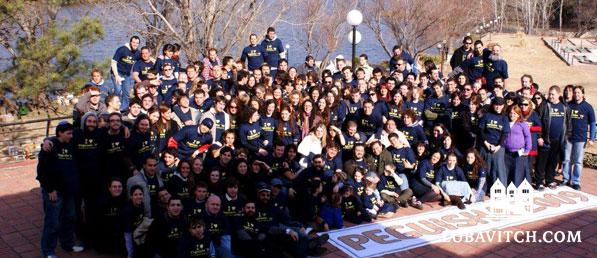(lubavitch.com) There are a quarter of a million Jews in Argentina today. But “seven out of ten are dating non-Jews, and the rate of intermarriage is rising,” says director of Chabad in Argentina Rabbi Tzvi Grunblatt.
Bearing this in mind, Chabad representatives in the country work creatively and energetically, and, in small but steady increments, they are helping young Jews defy the statistical odds, making Jewish marriages instead of intermarriages.
Rabbi Shlomo Levy of Chabad in Palermo, hung out his shingle in 1996, determined to find a way to engage local students. In the Chabad center, Centro Para le Juventud, there’s a pool table, play station, a ping pong table and a full bar facing a large, comfortable lounge. Levy’s work is informed by a firm belief that if the ambience is right and students feel at home, they’ll enjoy being Jewish and Judaism will become a real part of their lives.
He’s proving his conviction. Today, 400 students pass through his doors every week. Twenty five to thirty students, along with many local professionals, explore Jewish themes in daily study classes. Thursday night is party time for Argentine youth, but instead of clubbing, upwards of 150 Jewish students – who live at home, there are no dormitories on campus in Argentina – stay out late at the Chabad center, sitting in on night classes or just schmoozing with friends in a Jewish environment.
“Until thirty years ago, there was never a structured Jewish community in Argentina, because the Jews who moved here from Europe one hundred years ago did so for two reasons: firstly, because of poverty, and secondly due to political unrest,” says Grunblatt, who has established 35 Chabad centers around the country.
This was not an incentive for strong Jewish leaders who had their communities and families to tend to, and could stay put as long as they didn’t feel physical persecution. When the local Jewish population did eventually become somewhat organized after the Holocaust, it was largely due to a strong Conservative movement, and a Zionist, secular culture which did little to promote Judaism in any real way, and failed to impact the next generation.
The large majority of Argentina’s Jews, about 200,000, are concentrated in Buenos Aires. In the 1960s, there were 50 Jewish day schools, run for the most part by the Conservative movement. Today, that number has dwindled to 25, and two of them are led by Chabad.
With 25 centers in Buenos Aires, Chabad provides a host of extracurricular Jewish classes reaching thousands of Jewish youth in many of the remaining schools. Intermarriage and assimilation, says Grunblatt, are still on the rise, but there has been a qualitative, discernible change in the general attitude toward Judaism.
“Forty years ago, asking someone to put on Tefilin was out of question. Today, most will agree to lay Tefilin. The Jewish community is very appreciative of Chabad’s work.”
Immediately after opening shop, Levy pioneered a simple yet effective initiative to draw in more college students. Participating students commit to attend a minimum of two classes a week and a few hours of volunteer work for the city’s poor and Holocaust survivors. At the end of the year, they are treated to a fully sponsored trip to New York for week.
It was a successful formula, prompting other Chabad centers in the city to do the same, eventually spawning ISEJ and Morasha, both programs of similar nature to Levy’s that reward students who complete the program with trips to New York and Israel.
Encountering the rich Jewish life they find in New York or Israel, many students extend their stay and go on to study at some of the well known yeshivas for adult students.
Paula Ini, 27, joined Rabbi Levy and 450 students on last year’s trip, which ended on January 3. She’s chosen to remain, and is now studying at a women’s yeshiva in New York.
“I was raised in a secular home. When I was 16, I was going through a very difficult time in my life, I was very unhappy,” she recalls. Though their library lacked Jewish books, Ini unexpectedly found the book, Toward a Meaningful Life one night, and stayed up reading the book cover to cover. “When I finished I saw the picture of a Rabbi on the back of the book, and I felt very close to G-d after reading that, and seeing that picture.”
Ini only found out about the identity of the man in picture, the Lubavitcher Rebbe years later, after she returned from Israel and got involved at Levy’s Chabad center. Now, she says, “I’m sitting not two blocks away from the Rebbe’s synagogue.”
Centro Para le Juventud serves as a great meeting ground for Jewish singles, and Levy is busy these days officiating at two to three weddings a month–each of these once a likely intermarriage. After marriage, many return to settle in Palermo, and Levy is now plotting a course for a younger community with a new synagogue and other community events. He still keeps in touch with some 15,000 students that he’s met over the years.
“The student programs are very effective in the battle against intermarriage. More than 30 matches are made every year, when students meet through these programs,” Grunblatt points out.
Michel Ruszniak , 29, is now extending his ticket so he can tour the Big Apple before heading home.
Though his original itinerary included a tour of NYC, he preferred instead to abandon himself to the Jewish immersion experience he found with Chabad. In particular, he was moved by the introspective visit to the Ohel, the Rebbe’s resting place.
“One day we left for the Rebbe’s resting place at eight a.m., and ended up staying there until late afternoon instead of touring the Rockefeller Center,” he says. “But we forgot all about it, we were enjoying the spirituality so much.”

Be the first to write a comment.